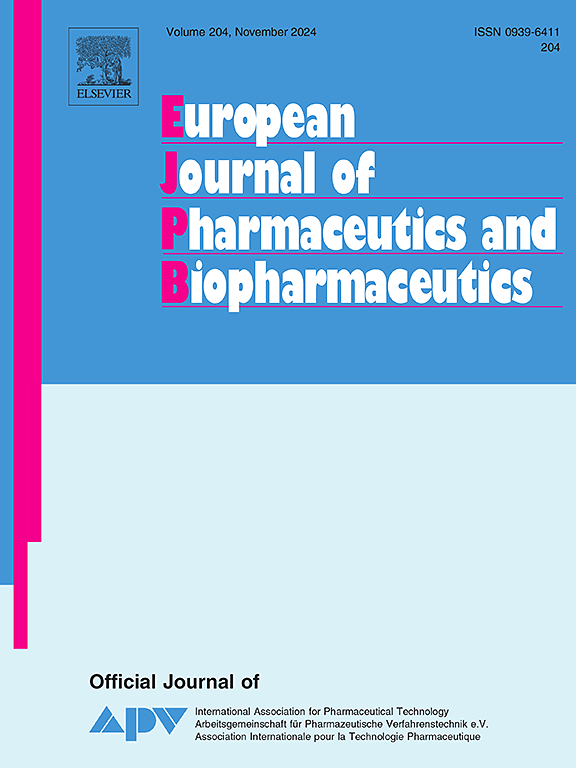A novel directly compressible co-processed excipient, based-on rice starch for extended-release of tablets
IF 4.4
2区 医学
Q1 PHARMACOLOGY & PHARMACY
European Journal of Pharmaceutics and Biopharmaceutics
Pub Date : 2025-01-27
DOI:10.1016/j.ejpb.2024.114623
引用次数: 0
Abstract
The development of a direct compression excipient with extended-release property is crucial for improving tablet manufacturing and drug delivery. This research focuses on developing a novel co-processed excipient composed of rice starch (RS), methylcellulose (MC), and colloidal silicon dioxide (CSD) using a wet granulation technique. The ratios of RS: MC (1.66:1–1:3) and CSD concentrations (1.0 – 8.26 %) on the properties of co-processed material were evaluated. The RS co-processed with MC and CS (RMSs) formed agglomerate particles (199 – 294 μm of average particle size) with irregular shapes and rough surfaces due to the wet granulation technique. FT-IR spectroscopy confirmed that there was no change in the chemical structure during co-processing, while the amorphous characteristic of MC considerably decreased the crystallinity of the RMSs. The increase in the particle size and the bulk density of the RMSs improved material flowability (17 – 18° for angle of repose) and facilitated particle rearrangement during die filling. RS plasticity promoted material compressibility, while the brittleness of CSD contributed to the increased tablet tensile strength. The elastic recovery of RMSs relied on the ratio of RS, which facilitated permanent bonding, whereas incorporating CSD reduced the lubricant sensitivity of material. The co-processing with MC significantly improved material swellability and effectively maintained the polymer matrix for a long period in media with pH 1.2, 4.5, and 7.5. The in vitro release study confirmed the ability of RMSs to prolong drug release from the matrix tablets, where the cumulative drug release of RMS-2 tablets met the specification and conformed with Higuchi model. Among the RMSs, RMS-2 (RS co-processed with 48.7 % MC and 2.68 % CSD) exhibited the optimal ratio of co-processing, as it demonstrated more favorable compression behavior and extended-release property than other RMSs. These findings indicated that RMSs could potentially be used as a direct compression excipient with extended-release properties.

一种新型的直接可压缩协同加工赋形剂,以大米淀粉为基础,用于片剂的缓释。
开发具有缓释特性的直接压缩赋形剂对于改善片剂生产和给药性能至关重要。本研究的重点是利用湿造粒技术开发一种由大米淀粉(RS)、甲基纤维素(MC)和胶体二氧化硅(CSD)组成的新型共加工赋形剂。考察了RS: MC(1.66:1-1:3)和CSD浓度(1.0 ~ 8.26 %)对共加工材料性能的影响。RS与MC和CS (RMSs)共处理后,由于湿法造粒,形成了形状不规则、表面粗糙的团聚颗粒(平均粒径199 ~ 294 μm)。FT-IR光谱证实,在共加工过程中,化学结构没有发生变化,而MC的无定形特性大大降低了RMSs的结晶度。颗粒大小和堆积密度的增加提高了材料的流动性(休止角为17 - 18°),并促进了模具填充过程中的颗粒重排。RS的塑性提高了材料的压缩性,而CSD的脆性提高了片剂的抗拉强度。RMSs的弹性恢复依赖于RS的比例,这有助于永久粘接,而加入CSD则降低了材料的润滑剂敏感性。与MC的协同处理显著提高了材料的膨胀性,并在pH为1.2、4.5和7.5的介质中有效地长时间维持聚合物基质。体外释放实验证实了RMS-2具有延长基质片释药的作用,其中RMS-2片的累积释药符合标准,符合Higuchi模型。其中,RMS-2(与48.7 % MC和2.68 % CSD共处理)表现出最佳的共处理比例,表现出较好的压缩性能和缓释性能。这些结果表明,rms有可能作为一种具有缓释特性的直接压缩赋形剂。
本文章由计算机程序翻译,如有差异,请以英文原文为准。
求助全文
约1分钟内获得全文
求助全文
来源期刊
CiteScore
8.80
自引率
4.10%
发文量
211
审稿时长
36 days
期刊介绍:
The European Journal of Pharmaceutics and Biopharmaceutics provides a medium for the publication of novel, innovative and hypothesis-driven research from the areas of Pharmaceutics and Biopharmaceutics.
Topics covered include for example:
Design and development of drug delivery systems for pharmaceuticals and biopharmaceuticals (small molecules, proteins, nucleic acids)
Aspects of manufacturing process design
Biomedical aspects of drug product design
Strategies and formulations for controlled drug transport across biological barriers
Physicochemical aspects of drug product development
Novel excipients for drug product design
Drug delivery and controlled release systems for systemic and local applications
Nanomaterials for therapeutic and diagnostic purposes
Advanced therapy medicinal products
Medical devices supporting a distinct pharmacological effect.

 求助内容:
求助内容: 应助结果提醒方式:
应助结果提醒方式:


